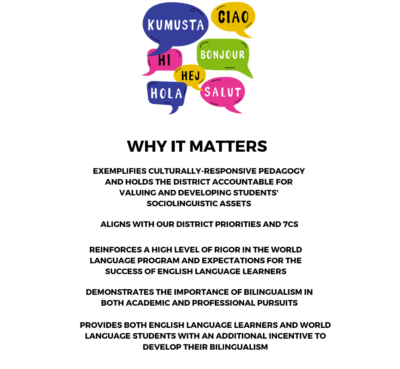BV BOE Program Report and Evaluation of Culturally and Linguistically Diverse Students – by Carly Winchell – Ark Valley Voice
BV BOE Program Report and Evaluation of Culturally and Linguistically Diverse Students - by Carly Winchell The Ark Valley Voice

Culturally and Linguistically Diverse Students in Buena Vista School District
Buena Vista Middle and High School

Buena Vista Middle and High School. Photo by Carly Winchell
At the recent Buena Vista Board of Education meeting, there was a significant focus on the education of Culturally and Linguistically Diverse (CLD) students, also known as English Language Learners (ELL). The Board received reports and evaluations from various programs, but the community has been particularly concerned about the ELL program.

Buena Vista School District Logo courtesy bvschools.org
ELL Program Overview
Nancy Jones, an Elementary ELL Teacher, and Angelee March, a High School Spanish Teacher, presented the ELL program at the meeting. Jones will be retiring at the end of the year.
Student Demographics
Currently, there are 41 students from kindergarten to twelfth grade who qualify for English Language Development services. Non-English Proficient (NEP) and Limited English Proficient (LEP) students make up 4.33 percent of the student population, which is a 2.8 percent increase from the previous year. These students speak languages such as Spanish, Mandarin, Albanian, Nepalese, Russian, Mongolian, Luxembourgish, and Amharic.
Approximately 78 percent of qualified students indicated Spanish as their home language.
Newcomer Students
The term “newcomer” refers to K-12 students who were born outside the United States and have arrived in the country within the last three years. In kindergarten through fifth grade, there are 16 newcomer students, with 12 enrolling this year. In sixth through twelfth grade, there are four newcomers. The district began developing a newcomer program in January of this year.
Community Support and Cultural Assets
The community received praise for embracing newcomer students and their families, recognizing the cultural and linguistic assets they bring. The presence of newcomer students has helped the entire student population prepare to interact with a diverse world.

Biliteracy certifications are now available for BV School District students who are proficient in more than one language. Image courtesy of the August 28 Buena Vista Board of Education meeting packet.
Challenges and Recommendations
Despite the positive aspects, the staff acknowledged the challenges of meeting the needs of newcomer students with limited resources and staff. They emphasized the need for more qualified CLD specialists, bilingual staff, and professional development to adequately serve the changing student population. Translation and interpreting services were also identified as areas needing improvement.
Superintendent’s Evaluation and Program Guide
Superintendent Lisa Yates presented the evaluation of the ELL program. The program’s belief statement emphasizes the unique assets that CLD learners bring to the schools and the importance of multilingualism. Yates mentioned commendations for the program’s flexibility and alignment with current research. Recommendations included providing more professional learning opportunities for staff to support newcomer students.
School Financing and CLD Students
During the meeting, there was a discussion about a state-level proposal regarding school financing for newcomer students. Superintendent Yates clarified that the proposal did not involve taking away funding from districts but rather included an additional multiplier for ELL, special education, rural, and other students to calculate funding.
Conclusion
The Buena Vista School District recognizes the value of CLD students and aims to provide them with a quality education. The district is committed to embracing newcomer students and their families, supporting their cultural and linguistic assets, and preparing all students for a diverse world.
References:
- Department of Education: Newcomer Students
- Highlights Slide of the Presentation
SDGs, Targets, and Indicators Analysis
1. Which SDGs are addressed or connected to the issues highlighted in the article?
- SDG 4: Quality Education
- SDG 10: Reduced Inequalities
- SDG 16: Peace, Justice, and Strong Institutions
The article discusses the challenges and efforts related to providing education and support to Culturally and Linguistically Diverse (CLD) students, also known as English Language Learners (ELL). This aligns with SDG 4, which aims to ensure inclusive and equitable quality education for all. Additionally, the article highlights the need for resources and support to address the needs of CLD students, which relates to SDG 10, as it focuses on reducing inequalities. Finally, the article mentions the importance of embracing newcomer students and their families, which contributes to fostering peace, justice, and strong institutions (SDG 16).
2. What specific targets under those SDGs can be identified based on the article’s content?
- Target 4.5: Eliminate gender disparities in education and ensure equal access to all levels of education and vocational training for the vulnerable, including persons with disabilities, indigenous peoples, and children in vulnerable situations.
- Target 10.2: By 2030, empower and promote the social, economic, and political inclusion of all, irrespective of age, sex, disability, race, ethnicity, origin, religion, or economic or other status.
- Target 16.7: Ensure responsive, inclusive, participatory, and representative decision-making at all levels.
Based on the article’s content, the specific targets that can be identified are as follows: Target 4.5, which focuses on eliminating gender disparities in education and ensuring equal access to education for vulnerable groups; Target 10.2, which aims to promote social, economic, and political inclusion for all individuals; and Target 16.7, which emphasizes the importance of inclusive and participatory decision-making processes.
3. Are there any indicators mentioned or implied in the article that can be used to measure progress towards the identified targets?
- Indicator 4.5.1: Parity indices (female/male, rural/urban, bottom/top wealth quintile, and others such as disability status, indigenous peoples, and conflict-affected, as data become available) for all education indicators on access, participation, and achievement.
- Indicator 10.2.1: Proportion of people living below 50 percent of median income, by age, sex, and persons with disabilities.
- Indicator 16.7.1: Proportions of positions (by sex, age group, persons with disabilities, and population groups) in public institutions (national and local legislatures, public service, and judiciary) compared to national distributions.
The article does not explicitly mention specific indicators. However, based on the identified targets, the following indicators can be used to measure progress: Indicator 4.5.1, which measures gender disparities and other inequalities in education; Indicator 10.2.1, which assesses the proportion of people living below a certain income threshold; and Indicator 16.7.1, which evaluates the representation of different groups in public institutions.
SDGs, Targets, and Indicators Table
SDGs Targets Indicators SDG 4: Quality Education Target 4.5: Eliminate gender disparities in education and ensure equal access to all levels of education and vocational training for the vulnerable, including persons with disabilities, indigenous peoples, and children in vulnerable situations. Indicator 4.5.1: Parity indices (female/male, rural/urban, bottom/top wealth quintile, and others such as disability status, indigenous peoples, and conflict-affected, as data become available) for all education indicators on access, participation, and achievement. SDG 10: Reduced Inequalities Target 10.2: By 2030, empower and promote the social, economic, and political inclusion of all, irrespective of age, sex, disability, race, ethnicity, origin, religion, or economic or other status. Indicator 10.2.1: Proportion of people living below 50 percent of median income, by age, sex, and persons with disabilities. Target 10.2: By 2030, empower and promote the social, economic, and political inclusion of all, irrespective of age, sex, disability, race, ethnicity, origin, religion, or economic or other status. Indicator 16.7.1: Proportions of positions (by sex, age group, persons with disabilities, and population groups) in public institutions (national and local legislatures, public service, and judiciary) compared to national distributions. SDG 16: Peace, Justice, and Strong Institutions Target 16.7: Ensure responsive, inclusive, participatory, and representative decision-making at all levels. Indicator 16.7.1: Proportions of positions (by sex, age group, persons with disabilities, and population groups) in public institutions (national and local legislatures, public service, and judiciary) compared to national distributions. Behold! This splendid article springs forth from the wellspring of knowledge, shaped by a wondrous proprietary AI technology that delved into a vast ocean of data, illuminating the path towards the Sustainable Development Goals. Remember that all rights are reserved by SDG Investors LLC, empowering us to champion progress together.
Source: arkvalleyvoice.com

Join us, as fellow seekers of change, on a transformative journey at https://sdgtalks.ai/welcome, where you can become a member and actively contribute to shaping a brighter future.








